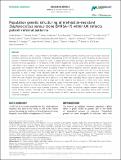Files in this item
Population genetic structuring of methicillin-resistant Staphylococcus aureus clone EMRSA-15 within UK reflects patient referral patterns
Item metadata
| dc.contributor.author | Donker, Tjibbe | |
| dc.contributor.author | Reuter, Sandra | |
| dc.contributor.author | Scriberras, James | |
| dc.contributor.author | Reynolds, Rosy | |
| dc.contributor.author | Brown, Nicholas M | |
| dc.contributor.author | Török, M Estée | |
| dc.contributor.author | James, Richard | |
| dc.contributor.author | Network, East Of England Microbiology Research | |
| dc.contributor.author | Aanensen, David M | |
| dc.contributor.author | Bentley, Stephen D | |
| dc.contributor.author | Holden, Matthew T. G. | |
| dc.contributor.author | Parkhill, Julian | |
| dc.contributor.author | Spratt, Brian G | |
| dc.contributor.author | Peacock, Sharon J | |
| dc.contributor.author | Feil, Edward J | |
| dc.contributor.author | Grundmann, Hajo | |
| dc.date.accessioned | 2017-11-13T16:30:15Z | |
| dc.date.available | 2017-11-13T16:30:15Z | |
| dc.date.issued | 2017-07-09 | |
| dc.identifier | 251486161 | |
| dc.identifier | f5ada48a-c772-4451-88a3-19becfea13f8 | |
| dc.identifier | 29026654 | |
| dc.identifier | 85053259392 | |
| dc.identifier | 000431155300002 | |
| dc.identifier.citation | Donker , T , Reuter , S , Scriberras , J , Reynolds , R , Brown , N M , Török , M E , James , R , Network , E O E M R , Aanensen , D M , Bentley , S D , Holden , M T G , Parkhill , J , Spratt , B G , Peacock , S J , Feil , E J & Grundmann , H 2017 , ' Population genetic structuring of methicillin-resistant Staphylococcus aureus clone EMRSA-15 within UK reflects patient referral patterns ' , Microbial Genomics , vol. 3 , no. 7 , e000113 . https://doi.org/10.1099/mgen.0.000113 | en |
| dc.identifier.issn | 2057-5858 | |
| dc.identifier.other | PubMedCentral: PMC5605955 | |
| dc.identifier.other | ORCID: /0000-0002-4958-2166/work/60196387 | |
| dc.identifier.uri | https://hdl.handle.net/10023/12072 | |
| dc.description | This work was supported by grants from the UK Clinical Research Collaboration (UKCRC) Translational Infection Research Initiative and the Medical Research Council (grant number G1000803) with contributions to the grant from the Biotechnology and Biological Sciences Research Council, the National Institute for Health Research (NIHR) on behalf of the Department of Health and the Chief Scientist Office of the Scottish Government Health Directorate (to S. J. P.); and by Wellcome Trust grants numbers 098051 and 089472 awarded to the Wellcome Trust Sanger Institute and B. G. S respectively. | en |
| dc.description.abstract | Antibiotic resistance forms a serious threat to the health of hospitalised patients, rendering otherwise treatable bacterial infections potentially life-threatening. A thorough understanding of the mechanisms by which resistance spreads between patients in different hospitals is required in order to design effective control strategies. We measured the differences between bacterial populations of 52 hospitals in the United Kingdom and Ireland, using whole-genome sequences from 1085 MRSA clonal complex 22 isolates collected between 1998 and 2012. The genetic differences between bacterial populations were compared with the number of patients transferred between hospitals and their regional structure. The MRSA populations within single hospitals, regions and countries were genetically distinct from the rest of the bacterial population at each of these levels. Hospitals from the same patient referral regions showed more similar MRSA populations, as did hospitals sharing many patients. Furthermore, the bacterial populations from different time-periods within the same hospital were generally more similar to each other than contemporaneous bacterial populations from different hospitals. We conclude that, while a large part of the dispersal and expansion of MRSA takes place among patients seeking care in single hospitals, inter-hospital spread of resistant bacteria is by no means a rare occurrence. Hospitals are exposed to constant introductions of MRSA on a number of levels: (1) most MRSA is received from hospitals that directly transfer large numbers of patients, while (2) fewer introductions happen between regions or (3) across national borders, reflecting lower numbers of transferred patients. A joint coordinated control effort between hospitals, is therefore paramount for the national control of MRSA, antibiotic-resistant bacteria and other hospital-associated pathogens. | |
| dc.format.extent | 12 | |
| dc.format.extent | 1302935 | |
| dc.language.iso | eng | |
| dc.relation.ispartof | Microbial Genomics | en |
| dc.subject | Antimicrobial resistance | en |
| dc.subject | Hospital network | en |
| dc.subject | MRSA | en |
| dc.subject | RA0421 Public health. Hygiene. Preventive Medicine | en |
| dc.subject | QR Microbiology | en |
| dc.subject | DAS | en |
| dc.subject | SDG 3 - Good Health and Well-being | en |
| dc.subject.lcc | RA0421 | en |
| dc.subject.lcc | QR | en |
| dc.title | Population genetic structuring of methicillin-resistant Staphylococcus aureus clone EMRSA-15 within UK reflects patient referral patterns | en |
| dc.type | Journal article | en |
| dc.contributor.institution | University of St Andrews. School of Medicine | en |
| dc.contributor.institution | University of St Andrews. Infection Group | en |
| dc.contributor.institution | University of St Andrews. Infection and Global Health Division | en |
| dc.contributor.institution | University of St Andrews. Biomedical Sciences Research Complex | en |
| dc.identifier.doi | https://doi.org/10.1099/mgen.0.000113 | |
| dc.description.status | Peer reviewed | en |
| dc.identifier.url | http://mgen.microbiologyresearch.org/content/journal/mgen/10.1099/mgen.0.000113 | en |
This item appears in the following Collection(s)
Items in the St Andrews Research Repository are protected by copyright, with all rights reserved, unless otherwise indicated.

